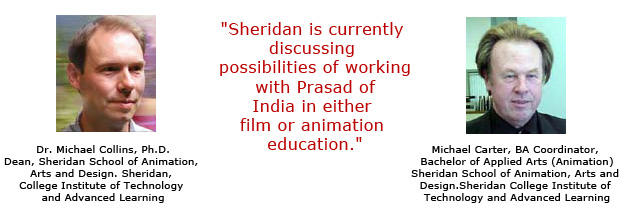
Animation ‘xpress exclusive Q&A with
Sheridan School of Animation, Arts and Design Dean Dr Michael Collins and Coordinator Michael Carter
The progress of Indian animation is constantly haunted by the paucity of well groomed animators. Quite a few Indian institutes are now in the process of expanding and improving the quality of their animation training, at least they are saying so. As they try and devise the perfect curriculum, we at Animation ‘xpress thought it was the right time to speak to some of the world’s leading animation schools.
Following are excerpts from Animation ‘xpress’ exclusive Q&A with
Sheridan School of Animation, Arts and Design Dean Dr Michael Collins and Coordinator Michael Carter
What are the essentials of animation training? What should people who devise courses look at when they set out to structure new ones?
(Respondents: M. Collins, Michael Carter)
The first essential of animation training is to develop the drawing skills of the interested student or, to begin with students who wish to learn animation only after they have established strong drawing skills. These drawing skills must be academic. The student must know how to represent the world of objects and architecture according to the rules of perspective rendering and the student must be able to accurately represent human and animal subjects paying particular attention to proportion, structure and surface anatomy.
Once the students know how to draw well, they can begin learning how to animate. They will still need to continue drawing practice in all of these areas discussed above while they are engaged in their animation training. A typical training program in animation would include courses in animation, layout, storyboarding, character design and development. Students might also study art direction and the history of animation.
Students should have a firm understanding in the development of a story idea/script. Further, a historical perspective in characters from literature and history helps to anchor the story. Acting provides a base in which both the story and the character are realized visually. Thus, the student should have a holistic exposure to what might be considered as non-traditional animation curriculum in order for their visual experience to be as convincing and vibrant as possible.
Someone who is setting out to devise new courses in any of these areas should follow the structure outlined above in terms of content.
It is also important to note that animation comes in many forms and styles. 2d, cgi-3d, stop motion, sand, painting, puppets. We should not overlook the value and tradition of these other forms of animation. India for instance, has a rich heritage in terms of puppet and shadow animation. This is a value set of cultural perspectives in animation
which is unique to India.
Today students must learn how to translate the animation layout and storyboard procedures traditionally developed through graphic means into computer formats either in 2-D or 3-D. This typically requires students to become knowledgeable in animation software packages such as Maya. These packages require a significant amount of time in order to obtain proficiency. The writer of the course has to balance the graphic
understanding which the student needs to have developed against the capacities of the software.
Although software is an important part of the new process of animation production, the application of the software isn’t. What needs to be reinforced is the base understanding of what animation is and how it is applied.
“The first essential of animation training is to develop the drawing skills of the interested student .”

You have been to India recently for FICCI Frames, I am sure you have an idea of how the Indian animation training institutes function. What according to you is it that lags in the Indian training system?
Indian animation training seems to be well on its way to an understanding of the computer software packages used in animation and layout. However, Indian students seem to lack the graphic foundation that is required in the Sheridan program. This lack of understanding of the graphic frame of reference makes graduates slower and less flexible in their creativity.
How long does it ideally take for a raw (yet eager) student to reach a level of a professional animator?
While a student may become functional in an animation studio within 2- 3 years of study, becoming a professional animator is a life long task. To understand how to use animation to create not only great acting but also great scenes and eventually a great film requires both experience and study that go beyond short training programs. This is one of the reasons why Sheridan now offers a four-year baccalaureate degree.
Are there any plans for Sheridan to enter India, any tie ups, any franchises?
Sheridan is currently discussing possibilities of working with Prasad of India in either film or animation education. We may also be able to extend our current agreement with NID which allows for student/faculty exchanges to include some joint educational endeavors.
These potential linkages suggest an exciting future but I must stress that they at this moment remain potential.
 “Becoming a professional animator is a life long task”
“Becoming a professional animator is a life long task”
Tell us about the latest courses at Sheridan? How can Indian applicants (students) prepare themselves if they wish to enroll at Sheridan?
One of the most recent offerings at Sheridan consists of two summers of study in Computer Animation, Character Animation, and/or Digital Special Effects. Students can complete a post- diploma certificate in those areas by participating in 2 summers of study. Successful Indian applicants for these coursers will probably be graduates from art colleges or university programs which offer art in an applied context. Sheridan will also consider applicants with significant industry experience in lieu of formal education in the arts. However, all applicants will have to submit a portfolio representing their
accomplishments. It goes without saying that students should have strong graphic skills.
There’s a lot of modular courses being churned out by Indian institutes, they do spruce up skills of students in a particular procedure of animation , say compositing or modeling. But the student’s overall development as an animation film maker is overlooked. Is that wise? What are your comments?
The demand in India for students skilled in particular procedures in animation is high at the moment and no doubt one way to meet that demand is to offer short modular courses focused on those specific procedures. This approach seems to be necessary in the current market context in India. Students however, when they don’t understand
the graphic skills and the graphic language needed to create an image using the computer run the risk of become ungrounded and somewhat disconnected from the essential components of animation. Even so, many students who have a limited knowledge, but are at a high level, will no doubt be able to find work in the animation field in the current Indian market.
How many students does Sheridan(animation & 3D) teach in a year? How many animators from theUSare added to theUSanimation industry every year?
Currently Sheridan has five programs in animation and related computer animation fields. The total enrollment is approximately 400 and is expected to grow by about 25% within two years.
As 3d becomes prevalent, do you think that raw students could be trained straight into 3d? or is 2d training essential to animation?
Students can be trained to work directly in 3D animation as long as they have strong drawing and/or painting skills. Training in 2D animation is not necessarily required in order to facilitate work in a program like Maya.
Sheridan continues to explore the convergence potential within the film and animation industry generated by the digital revolution and at the same time to maintain the graphic skills that make digital tools exactly that tools.